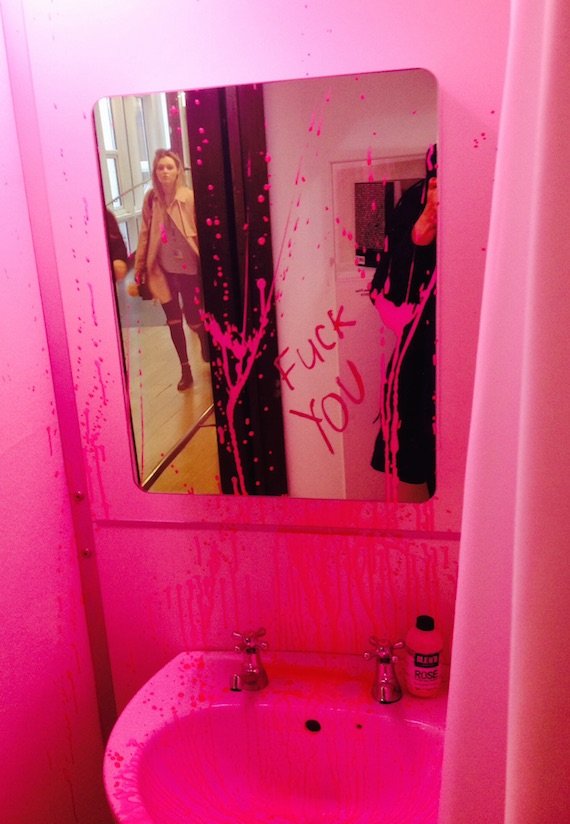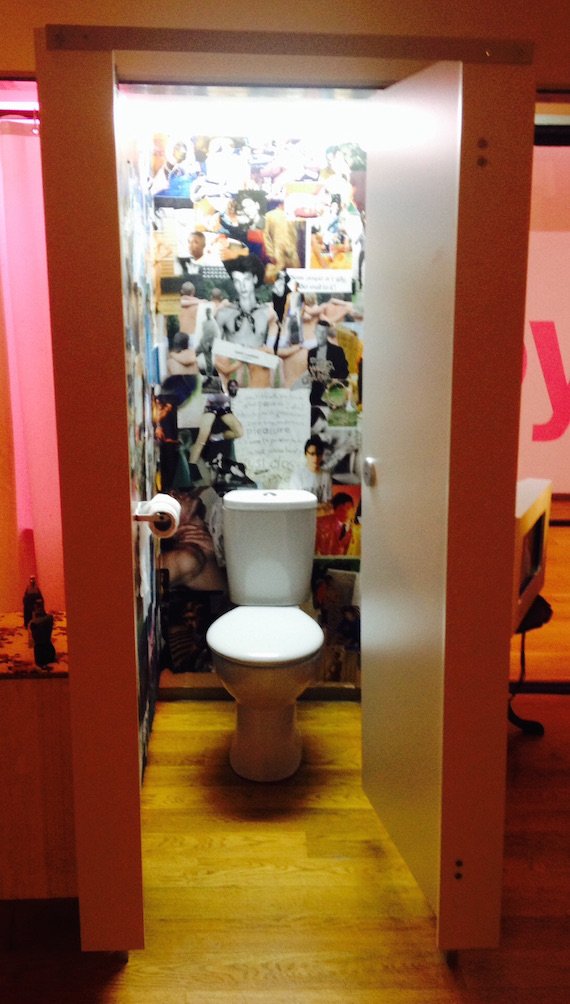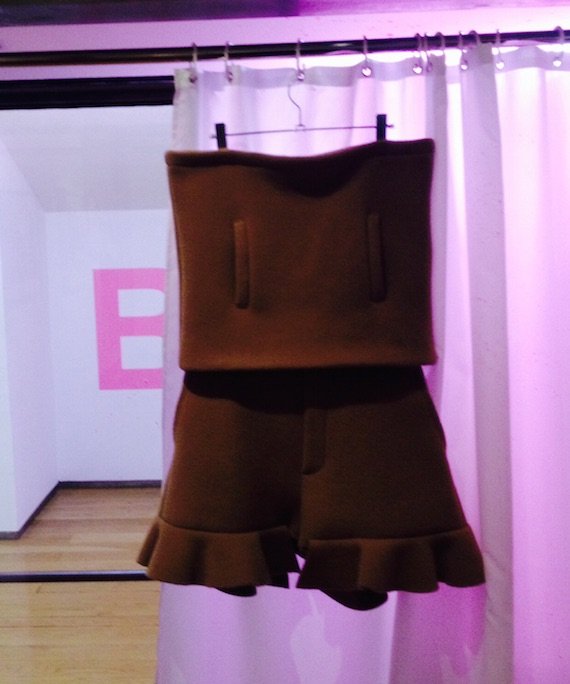Mad About the Boy At The Fashion Space Gallery
March 19, 2016If you have any interest in fashion, go and catch this show “Mad about the boy” in its last weeks at the University College of London’s Fashion Space Gallery. Even if you’re into women’s wear and not mens, go – it’s a great insight into the ideas and motivations behind certain collections.
Mad About the Boy
Fashion Space Gallery until 02.04.2016
Mad About The Boy contains lots of imagery and articles, but it’s not just a white-walled gallery space of large glossy photographs of fashion spreads, unobtrusively framed in neat aluminium, as I had imagined. Instead, curator Lou Stoppard gives us an intensely thought through presentation of the influences – what can almost be called urges – behind the menswear of many catwalk designers today. The display of the items works hard to be unconventional, and the commentary on the sections is extensive.
Mad About the Boy – Teenage Dreams
The exhibition begins downstairs, in UCL’s tiny “shop window”, just off Oxford Circus. Tony Hornecker, the set designer for Meadham Kirchhoff’s Spring Summer 2013 show, has recreated a part of it in a cramped space visible from the street. The collection was called (Br)Other By Proxy, and its themes were nostalgia for youth, even at the moment that youth is left behind. Hornecker’s set recalls a claustrophobic teenage boy’s bedroom, messy with draped and hanging clothes. You find yourself amidst the clutter, picking your way over the discarded duvet and peering at the objects partly intrigued, partly repulsed, partly embarrassed and partly with a creeping feeling that the boy whom the room belongs to might bang open the door at any time and slouch in – with untold consequences. Anger? Seduction?
Teenage dreams and specifically teenager’s bedrooms are often explored in the work of contemporary artists – David Hancock with his meticulous renditions of the hideaways of Manchester goths springs to mind – but I hadn’t realised that fashion designers took teens as an inspiration too. Of course, male catwalk models are often lithe, awkward looking teenagers, but I thought they were just there to model the clothes and not necessarily muses. If what this exhibition posits is true – and it is a strongly argued case – memories of painful adolescence and/or male adolescents themselves are a strong source of inspiration for designers. It is the opposite of the feeling I get with female models who are of course a similar age and body type – these girls, the models themselves, are just a moving figure for designers to pin their ideas and fantasies on, ideas and fantasies which are often completely divorced from the female form itself.
The Peter Pan complex
Neither the feeling nor the imaginary boy himself is attractive to me, but according to Mad About the Boy for many gay male fashion designers (and gay male designers are in the majority in the fashion industry) adolescence is a compelling world. JM Barrie created Peter Pan in 1902, a cheeky, cruel, energetic, and careless boy whose body is slender and hairless. This version of early manhood is a seductive one. Peter Pan never grows up, and whilst these designers aren’t interested in children, they are intrigued by adolescents in the stage before they broaden out, grow beards and put on a bit of a tummy.
I haven’t been to the Fashion Space Gallery before and because many private galleries are tiny – I know of one that was situated in the hallway of a private flat in Berlin – I wondered at first if this shop window comprised the entire exhibition. Certainly, there was plenty to look at. But pass beyond this and the friendly security at the desk will give you a visitor sticker and direct you upstairs. Don’t be put off by this – all are welcome and the exhibition is free.
Mad About the Boy – Sex and violence
In the space upstairs, the feeing of intrigue and unease continues. I think: “This reminds me of Kids”, the 1995 Larry Clark film, and glancing round, it is actually playing on a TV in the corner. This film, if you haven’t seen it, caused a scandal at the time of its release as the director (who was in his 40s) hung around a skate park to recruit a team of inexperienced teenage writers and actors to create his movie, which was about the drug taking and sex lives of very young teens and pre-teens and seemed voyeuristic. It also included uncomfortable scenes of casual violence and rape. The exhibition argues that these kind of character exemplify glamour for some designers.
The large room is broken up with both panels and changing room sized cubicles which lead you to peer around corners and through slits. It isn’t a huge space, but, as downstairs, there is plenty to see. The exhibition is divided up into themes such as In The Street, As Sexual Object, Between Genders, As Outsider, Between Man And Child, In His Space, In The Club, and In Education.
The layout is imaginative, with outfits hung flat against walls, clothes displayed on rotating mannequins, on static display stands and tossed in a play tent. A recording plays excerpts from interviews with designers, photographers and taste makers on the subject. There are framed photographs, books displayed in perspex boxes, and as well as the play tent an armchair apparently recently vacated by a slumped teen, a washbasin with hair dye balanced in its rim, and a toilet cubicle collaged with images torn from magazines. Static, this show is not.
Between Man And Child
The play tent is pitched on the floor in the Between Man And Child section. Designers like Patrick Robyn and J.W. Anderson explore childish emblems like teddybears and cartoons, made to adorn young men, not children. The idea of the man-child seems very seductive to them.
In The Street
Whilst peering into the play tent, my eye was repeatedly caught by a flash of movement across the room as a black clad mannequin rotated in its cubicle. It felt like someone was waiting around the corner. That someone, on investigation, was wearing sportswear (and a mask) and was part of the In The Street section. This sportswear was by Nasir Mazhar but the menacing figure reminded me of teenage rioters in their Adidas and covered faces breaking windows, burning and stealing in the Tottenham riots of 2011, mostly just because they could. This version of Peter Pan is unreliable and dangerous. It is an idea that can also be attractive to gay men – the tough, macho, straight man who might actually beat them up if they made a move – but might equally be secretly attracted to them in return.
Mad About the Boy – In Education
Other cruel and unreliable teens include the ones from the school yard – the “In Education” section included designer Raf Simons’s revisitation of his school days with a childishly graffitied lab coat from his AW 15 collection. This referenced the custom in his school (and many others) of signing a shirt in the last days of term – a pleasant memory, you would think. But Simons’s collection also recalled the “hazing” ceremony he went through as a youth, when his feet were set in buckets of plaster, forcing him to stand upright for a whole day before being handed a hammer to smash his way out. His persecutors in this event wore these long white coats.
Mad About the Boy – In The Club
Club wear can go from Leigh Bowery’s crazy fetish inspired outfits to the 1970s uniform of Northern Soul fans, as In The Club attested. Music stars have always spawned legions of fans and imitators, and whilst some designers reference the rock stars they idolise, others idolise the idolisers with catwalk tributes to the fans themselves. A Raf Simons outfit from SS 2016 hangs on the wall, composed of a tattered and shrunken tank top and oversized flares. It looks realistically vintage.
Mad About the Boy – As Outsider
As Outsider refers to fashion’s admiration of rebels and bad boys. This is where the film Kids comes in, as well as anti-heroes like skinheads. As the explanation on the wall explains: “Underpinning fashion’s relationship with the male outsider is the cliche that “boys will be boys”, and that violence, insolence and rebellion are essential facets of masculinity, and therefore somehow desirable, attractive and even aspirational.”
Mad About the Boy – Between Genders
Between Genders is an exploration of male androgyny. A pretty, ruffled pair of wool shorts by J. W. Anderson hangs in the window, paired with a matching strapless bustier. This outfit is typical of his ideas about gender fluidity and genderless dressing. “Feminine” details such as bows and frills are worn with panache and male prettiness is celebrated. Gender fluidity is a hot topic at the moment, and this mood is creeping into both mens and womenswear – Alessandro Michele has created some great collections for Gucci where men wear lace tops and pussy bow ties and women, fitted sequin suits.
As Sexual Object
As Sexual Object is another uncomfortable area for me, with photos by Joseph Szabo titled Almost Grown, from 1978, of sleeping youths set next to works by Minoru Shimizu and Wolfgang Tilmans from 2005 and Gosha Rubchinskiy from 2015 which focus in on young male crotches. From the wall text: “The overt sexualisation of the male youth is not scrutinised to the same levels [as females]. Often the boy becomes an object of fantasy within editorials, playing out numerous roles, from the boy next door or cheeky Jack the lad to the awkward, shy, inexperienced teen. Sexual fancies are sometimes seemingly reconstructed, as the boy becomes handsome, sexually charged, inquisitive and testosterone charged before the lens.”
Mad About the Boy is a thoughtful, if uncomfortable exhibition that taught this reviewer a few things about men’s fashion.





